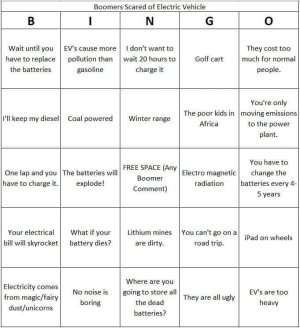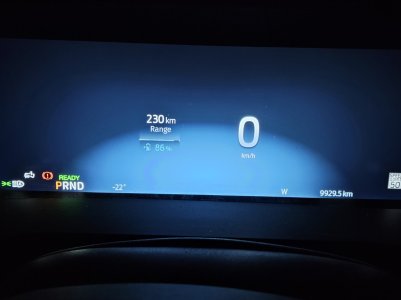Maxpri
Well-Known Member
All good manSorry my bad. Read that as illegal.
All good manSorry my bad. Read that as illegal.
How many squares in the EV bingo card does this one mark off?Hi, I think we have the most EV’s in Canada because we have the warmest weather in Canada and I don’t believe the battery would hold a charge during winter time anywhere else.
The correct price for electricity is “user pay”. I would not count on freebies in the future. The plan right now is to get us out of our gas guzzlers and into vehicles which limit our freedom to travel as we choose.
I like to go to remote locations.
What I dont get is people who think they are saving the environment by going E-V.
The amount of mining thats involved and the method is immoral. And much of the electricity is at times generated from “dirty” sources. And the disposal of the batteries are a nightmare. I don’t know if they can be recycled.
Please keep this thread updated. Everything is all rosy now, being shiny and new, but I would be curious as to how safe from electrical malfunction E-V’s actually are. Also I would be interested in their eventual resale value.
Thanks

Considering they have sensors that won't allow you to spin out on acceleration, and regenerative breaking. Traction is better than most ICE vehicles on the road.What’s the traction like on slippery roads?
So if it’s winter and you are in and out of the cab when its pouring rain, I guess you would need to have the defrost and heat on constantly to keep the inside of the windows clear. Maybe just get an independent portable heater that can blow hot air.I mentioned previously how quickly Lightning heats up cabin and defrosts the glass. But yesterday when it was snowing heavily, I found a downside to that. I was running a bunch of errands around town, lumber yard, different suppliers, etc, and the snow kept accumulating quickly. Every time I got back in, it went through the same rapid defrost. In a gas truck, this would be "free of cost" because the engine is warm now and waste heat gets everything clear. But EV has no waste heat, from an energy use point of view it's like starting from cold. I drove maybe 30 km all day but used 80 km of range! But whatever, plug in at home and all full in morning. On a longer trip you wouldn't have the snow accumulation etc so this wouldn't be an issue.
1. I live in the Okanagan, not much rain any time of year. 10 mm in 24 hours is a big day for us!So if it’s winter and you are in and out of the cab when its pouring rain, I guess you would need to have the defrost and heat on constantly to keep the inside of the windows clear. Maybe just get an independent portable heater that can blow hot air.
Moot point, Apex has all lifts closed today due to cold. Although I do need to go up there sometime this weekend to grab my skis and stuff for a trip to Sun Peaks the weekend after this.I'm curious, is the cab heater just electric resistance or does it use a heat pump (or both)? Most heat pumps don't work well at all below about -20C.
Any report on a trip to Apex in current conditions? I just checked the mountain report: -32C plus windchill... Based on your previous calc of -1% for every degree below 20C, you are basically starting with half charge. I imagine coming back to the truck after its sat in the lot for 6 hours, the range must be low, but at least its all downhill home.
They have a charger in the parking lot, but I think that's only if you are staying in the lodge.
In fairness, skiing in -30C is a terrible idea anyway.
From here on, I'm plugging in every night and setting departure time for the morning so the battery is preconditioned. Nice to see that the ChargePoint home charger cable remains flexible and easy to handle in -20 weather. Favorable reviews on this point were a part of my choice of this model.
Chargepoint Flex Home. Set for 40 amps as that was the most my 100A service could handle. Derate 25% as per code, so it charges at 32A for a flow rate of 8 kW. The amp setting is via internal dip switches so it can't be inadvertently changed in the app. There are cheaper chargers out there, but I went looking for ratings and reviews that indicated a cable that stayed flexible in the cold, and a good reporting system so I can justify my energy use to CRA for tax purposes.Which ChargePoint charger do you have?

I'm up here now. It's cold and everything is closed. Bummer. This was the annual ski trip. Cars are starting, but they are laboring. Not electric trucks.I'm curious, is the cab heater just electric resistance or does it use a heat pump (or both)? Most heat pumps don't work well at all below about -20C.
Any report on a trip to Apex in current conditions? I just checked the mountain report: -32C plus windchill... Based on your previous calc of -1% for every degree below 20C, you are basically starting with half charge. I imagine coming back to the truck after its sat in the lot for 6 hours, the range must be low, but at least its all downhill home.
They have a charger in the parking lot, but I think that's only if you are staying in the lodge.
In fairness, skiing in -30C is a terrible idea anyway.
